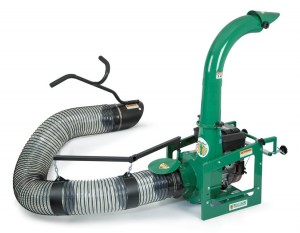 Are you having trouble getting your debris loader going at the start of leaf season? Is there an intermittent problem that’s giving you a headache? Here’s how you can solve the most common problems with Billy Goat’s line of DL debris loaders.
Are you having trouble getting your debris loader going at the start of leaf season? Is there an intermittent problem that’s giving you a headache? Here’s how you can solve the most common problems with Billy Goat’s line of DL debris loaders.
Unclogging Your Loader
Several problems can be traced to a clog somewhere in your debris loader. Here’s how you can clear it safely:
1. Shut off the engine. Wait until the engine and impeller come to a complete start.
2. Disconnect the spark plug wires and battery cables. This prevents the engine from starting on accident. Remember that the impeller is directly connected to the crankshaft, so spinning it will turn the engine over.
3. Disconnect the hose from the impeller housing. Locate the clog.
Clogs inside the impeller can be removed from the intake. In some cases, you may need to unbolt the impeller cover to clear the debris completely. When removing the cover, be sure to unplug the interlock switch.
If there is a clog in the discharge chute, carefully unbolt and lift the chute off of the debris loader. The chute is heavy, especially when it’s jammed with debris. It’s a good idea to have a second person on hand to help lift the chute off of the loader. Remove the debris and reattach the chute.
Vacuum Performance is Poor
The loader needs to pick up some air along with the debris to function properly. Keeping the end of the nozzle and inch or two above debris will help the loader vacuum faster.
Check the hose and impeller housing for clogs that may be reducing airflow. Make sure there are no tears or holes in the hose that may be letting air in.
Vacuum performance will vary depending on the debris being removed. Wet leaves and grass are harder to pick up than dry leaves, so it will take more time to pick them up.
The Engine is Locked Up
This is almost always caused by a clog. If the hose and impeller are clear, then there’s something wrong with the engine. Have it looked at by a professional mechanic.
The Engine Won’t Turn Over
If you have an electric start engine, check the battery. It needs to have a good connection and be fully charged to power the starter. When used over a normal workday, the engine provides enough power to charge the battery fully. During the off-season, the battery should occasionally be recharged or be connected to a trickle charger to keep it from going flat. All electric start engines have a backup pull starter, so you don’t have to have a working battery to use your loader.
Your debris loader has an interlock switch that cuts the ignition if the hose isn’t connected to the impeller intake. When fitting the hose, make sure this flap-shaped switch is under the hose and hose clamp. Make sure the switch is plugged in, and the wiring is intact from the switch to the engine.
The Engine Turns Over, but Won’t Start
Does the engine have a stop switch, a fuel valve or a throttle? Make sure these are in their operating positions.
Make sure the spark plug wires are connected.
Honda and Vanguard engines have a low oil sensor that will cut the ignition. Check the oil level, and add more oil as needed.
Fuel will go stale in a month after purchase and only lasts up to three months when treated with a stabilizer. If you aren’t sure how old the fuel is, drain the tank and carburetor, then add fresh fuel. If you accidentally stored the engine with fuel during the off-season, you may need to clean the carburetor to restore fuel flow.
The Engine Runs, Then Dies
A small clog can temporarily turn into a big one as debris enters the hose. If the engine wants to stall as you vacuum, make sure there’s a clear path from the nozzle up to the discharge chute.
If there is too much oil in the engine crankcase, it can create drag on the crankshaft, slowing the engine until it stalls. Check the oil level and drain as needed.
Do You Need Parts for Your Debris Loader?
When you need parts or accessories for your Billy Goat equipment, visit www.billygoatparts.com. We’re an authorized dealer for Billy Goat and their partners including Briggs & Stratton and Honda Engines. That means when you order from us, you know you’re getting a quality OEM replacement. Our site makes it easy to get the parts you need with sections for commonly-ordered parts and a search engine with built-in parts diagrams. We can ship your order to any address in the U.S. or Canada.
